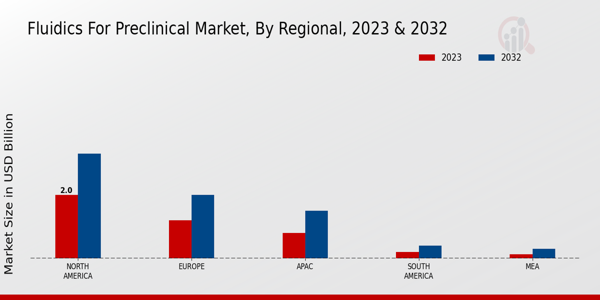Market Growth Projections
Growing Focus on In Vitro Testing
The Global Fluidics for Preclinical Market Industry is significantly influenced by the growing emphasis on in vitro testing methods. As researchers seek to minimize animal testing and adhere to ethical standards, fluidic systems provide viable alternatives for preclinical studies. These systems enable the simulation of biological environments, allowing for more accurate predictions of drug behavior in humans. The shift towards in vitro methodologies is likely to drive market growth, as fluidic technologies become integral to developing and validating new therapeutics. This trend aligns with global efforts to enhance research ethics and improve the efficiency of drug development.
Rising Demand for Personalized Medicine
The Global Fluidics for Preclinical Market Industry experiences a notable surge in demand due to the increasing focus on personalized medicine. As healthcare shifts towards tailored therapies, fluidic systems play a crucial role in enabling precise drug delivery and testing. This trend is underscored by the projected market growth from 4.9 USD Billion in 2024 to 9.56 USD Billion by 2035, reflecting a compound annual growth rate (CAGR) of 6.27% from 2025 to 2035. The integration of fluidics in preclinical studies enhances the efficiency of drug development, allowing for more accurate modeling of human responses, which is essential for personalized treatment approaches.
Increased Investment in Drug Development
The Global Fluidics for Preclinical Market Industry benefits from heightened investment in drug development, driven by the need for novel therapeutics. Pharmaceutical companies and research institutions are allocating substantial resources to preclinical research, recognizing the importance of fluidic systems in streamlining the drug development pipeline. This trend is evident as the market is expected to grow from 4.9 USD Billion in 2024 to 9.56 USD Billion by 2035. The increased funding supports the integration of sophisticated fluidic technologies, which enhance the accuracy and speed of preclinical testing, ultimately leading to more effective drug candidates entering clinical trials.
Regulatory Support for Innovative Research
Regulatory bodies are increasingly supporting innovative research methodologies, which positively impacts the Global Fluidics for Preclinical Market Industry. Initiatives aimed at accelerating drug approval processes encourage the adoption of advanced fluidic technologies in preclinical studies. By streamlining regulatory pathways, agencies facilitate the integration of fluidics into research protocols, thereby enhancing the efficiency of drug development. This supportive regulatory environment not only fosters innovation but also ensures that new therapeutic approaches can be tested more rapidly, contributing to the overall growth of the fluidics market in preclinical research.
Technological Advancements in Fluidic Systems
Technological innovations significantly drive the Global Fluidics for Preclinical Market Industry, as advancements in microfluidics and lab-on-a-chip technologies enhance experimental capabilities. These innovations facilitate high-throughput screening and precise manipulation of small fluid volumes, which are essential for modern preclinical research. The ongoing development of automated fluidic systems improves reproducibility and reduces human error, thereby increasing the reliability of experimental outcomes. As researchers seek to optimize drug discovery processes, the adoption of these advanced fluidic technologies is likely to expand, contributing to the overall market growth and efficiency in preclinical studies.














